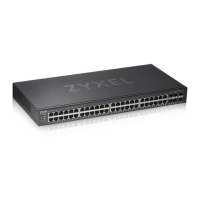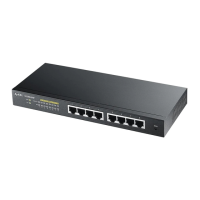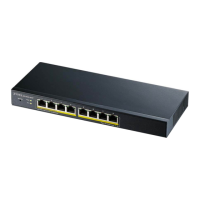Chapter 24 Multicast
GS1920 Series User’s Guide
196
Figure 138 Advanced Application > Multicast > IPv6 Multicast > MLD Snooping-proxy > VLAN
The following table describes the fields in the above screen.
Table 84 Advanced Application > Multicast > IPv6 Multicast > MLD Snooping-proxy > VLAN
LABEL DESCRIPTION
VID Enter the ID number of the VLAN on which you want to enable MLD snooping-proxy
and configure related settings.
Upstream
Query Interval Enter the amount of time (in miliseconds) between general query messages sent by
the router connected to the upstream port. This value should be exactly the same as
what’s configured in the connected multicast router.
This value is used to calculate the amount of time an MLD snooping membership
entry (learned only on the upstream port) can remain in the forwarding table.
When an MLD Report message is received, the Switch sets the timeout period of the
entry to be T = (QI*RV) + MRD, where T = Timeout, QI = Query Interval, RV =
Robustness Variable, and MRD = Maximum Response Delay.
Maximum Response
Delay
Enter the amount of time (in miliseconds) the router connected to the upstream port
waits for a response to an MLD general query message. This value should be exactly
the same as what’s configured in the connected multicast router.
This value is used to calculate the amount of time an MLD snooping membership
entry (learned only on the upstream port) can remain in the forwarding table.
When an MLD Report message is received, the Switch sets the timeout period of the
entry to be T = (QI*RV) + MRD, where T = Timeout, QI = Query Interval, RV =
Robustness Variable, and MRD = Maximum Response Delay.
When an MLD Done message is received, the Switch sets the entry’s lifetime to be the
product of Last Member Query Interval and Robustness Variable.
Robustness Variable Enter the number of queries. A multicast address entry (learned only on an upstream
port by snooping) is removed from the forwarding table when there is no response to
the configured number of queries sent by the router connected to the upstream port.
This value should be exactly the same as what’s configured in the connected multicast
router.
This value is used to calculate the amount of time an MLD snooping membership
entry (learned only on the upstream port) can remain in the forwarding table.

